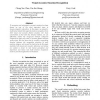60 search results - page 5 / 12 » Recognizing Human Emotion from Partial Facial Features |
ICMCS
2005
IEEE
13 years 11 months ago
2005
IEEE
To recognize and understand a person’s emotion has been known as one of the most important issue in human-computer interaction. In this paper, we present a multimodal system tha...
ACL
2004
13 years 6 months ago
2004
We examine the utility of speech and lexical features for predicting student emotions in computerhuman spoken tutoring dialogues. We first annotate student turns for negative, neu...
FGR
1998
IEEE
13 years 9 months ago
1998
IEEE
Current approaches to automated analysis have focused on a small set of prototypic expressions (e.g., joy or anger). Prototypic expressions occur infrequently in everyday life, ho...
ICIAP
2009
ACM
13 years 3 months ago
2009
ACM
Facial aging has been only partially studied in the past and mostly in a qualitative way. This paper presents a novel approach to the estimation of facial aging aimed to the quanti...
IWC
2006
13 years 5 months ago
2006
Conveyance and recognition of human emotion and affective expression is influenced by many factors, including culture. Within the user modeling field, it has become increasingly n...

